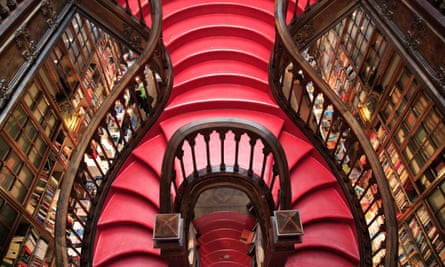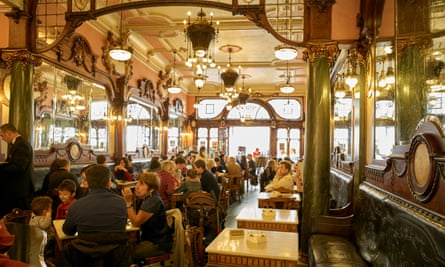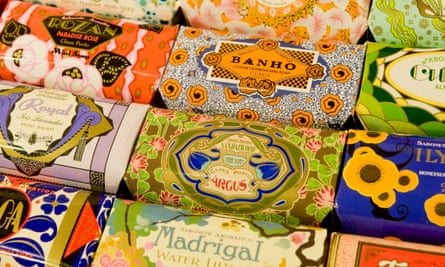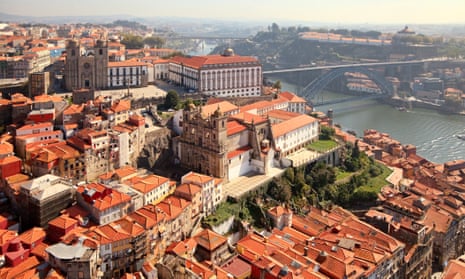Something odd is happening in Porto’s most famous bookshop. We arrive in the middle of the morning, after a leisurely breakfast of coffee and custard-filled pastéis de nata. The queue to get inside runs around the next block. At the ticket office, where access to the bookshop can be achieved by purchasing a ticket for €5, we are assured that it will take only 30 minutes until our turn. You read that correctly: people pay €5, and wait half an hour, just to get into a bookshop.
Mind you, Livraria Lello is not any old bookshop, which helps to explain the partyish atmosphere among the people waiting, with a busker playing jazz on the steps of a neighbouring department store.
Built in 1906, the shop’s architecture is a startling mix of neo-gothic and art deco, with a stained-glass skylight and a red-painted twisting staircase that supposedly inspired JK Rowling when she started writing Harry Potter (Rowling worked in Porto as an English teacher from 1991 to 1993).
Potter fans, leaping on this connection, were so keen to see the fantastical original that the shop couldn’t cope. The only way to deal with the flood was to charge for entry, with the price redeemable against a book if visitors choose to purchase one.

Suddenly, a bookshop that was struggling with huge crowds who didn’t buy much became, in effect, a museum. And with well over a million visitors each year, a museum that is doing very nicely. It’s also caused a pleasing rebound in book sales. But it’s not the most relaxing place to browse for books: amid the swarm of visitors taking selfies and filming entire movies on their phones, it’s a bit like hoping to pause before the Mona Lisa and take your own sweet time examining Leonardo’s brushstrokes.
Happily, other parts of Porto are not so overwhelmingly crowded, though locals report a massive change from around 2005 when much of the old town centre was deserted.
Richard Zimler, author of the bestselling Last Kabbalist of Lisbon, moved to Porto from San Francisco with his husband in 1990. It was very different then. Today, he’s something of a celebrity here: in 2017 he was awarded the city’s Medal of Honour. Describing the enormous change the city has witnessed over the past decade, he cuts through the queue from Livraria Lello to show a colourful historic street with bunting. This street, like many others, was empty and sad until a thriving movement of pop-up shops, and a determined mayor, revitalised the city centre.
Cheap flights increased the number of tourists, and large areas overlooking the beautiful Douro river, previously used by industries such as the port wine trade, became available for renovation.

The department store where the busker is playing provides a beautiful example of the newly confident city. A Vida Portuguesa, housed in a 19th-century warehouse, sells an inspired edit of Portuguese products – soaps, classic toys, ceramics, linens and more. In a globalised market where it can feel at times as though all products available anywhere are exactly the same, it’s wonderful to see so many exquisite things that are utterly unfamiliar.
And big brands from outside are keen to be part of Porto’s moment. The city’s grand and atmospheric hotel, Infante Sagres, has been painstakingly renovated. Next door, it has opened a Vogue Café (only a few cities around the world can boast one of these). We happened to be in town when guests arrived for the grand opening, from all over Portugal and beyond.
Throughout the city, threaded together by charming old wooden trams, Beaux Arts buildings are being renovated so that new cafés and boutiques can blossom. The Majestic Café, the city’s most famous café, was saved a few years ago from decay and is now back to its former glory. Newer buildings are added with great care, such as a complex of shops entirely covered with a living roof, creating a new city park with trees.
Porto is a good-looking city, its granite buildings packed into a hilly landscape, many of them decorated on the outside with azulejos, the stunning blue and white tiles that are a defining feature of this place. The entrance to the São Bento station is particularly memorable, covered in some 20,000 of these tiles depicting key moments in the history of Portugal.

We wander down the recently pedestrianised Rua das Flores with its pretty balconied houses and azulejo-clad Igreja da Misericordia. In a side alley there’s a striking blue and white mural of a cat on a wall several storeys high. We stop off for a craft beer and a plate of organic cheese and salamis at the Mercearia das Flores.
Here we find Claus Porto, Porto’s most famous soap brand, founded 130 years ago. Claus Porto is the brand that soap connoisseurs have bought as much for the beautiful packaging as the delicious soaps inside. The Porto shop opened last year, designed by the renowned Portuguese architect João Mendes Ribeiro. Upstairs, a museum traces the history of the brand, the distinctive wrappers redolent of the 20th century’s changing fashions in illustration.
We walk to Chocolataria Equador – and like the Claus Porto soaps, the chocolate bars are wrapped in exquisitely vibrant papers. We stock up on dark chocolate bars – walnut, fig, and passionfruit. It almost feels a crime to unwrap them, so lovely is the outer shell. Even the sardine cans in this city are beautiful. I’m not particularly keen on tinned fish, but it’s hard to resist the wonderful retro designs of Porthos, La Gondola and Minor.
Porto is hilly but walkable. From the Infante Sagres, it’s an easy stroll through the historic Ribeira district, classified by Unesco as a World Heritage Site. Climbing through the tangle of medieval streets to the old Jewish quarter, we find ourselves on a high terrace and admire the view across the city to the Douro. On the opposite bank in Vila Nova de Gaia, huge signposts among the riverside restaurants emblazon names of the iconic port lodges: Taylor’s, Sandeman, Croft, Fonseca, Symington, Calem...

Just below we find Armazém (warehouse in Portuguese), a vintage market full of fabulous antiques and a great place for lunch. Then a drink on the riverbank, which is splattered with brightly coloured houses in reds, blues and yellows. We wander across the bridge, built by a disciple of Gustave Eiffel. There’s one crossing just above the river, and another immensely higher: there can be few better places to get a sense of the city, and the powerful river.
On the far side, in Vila Nova de Gaia, we look back on Porto from the terrace of the Yeatman Hotel (part of the same group that owns Taylor’s and the newly restored Infante Sagres) where we enjoy a chilled white port. Below us, extensive building work is taking place to build a World of Wine – there are to be cafés, restaurants and museum space dedicated to the history of the city of Porto, Portuguese fashion and the amazing natural material that is cork.
We cross back into Porto, past the imposing cathedral, and hear the evening bells of the landmark Torre de Clerigos as we approach our hotel. We’ve time before dinner to climb the 225-step spiral staircase to the top, and catch the best view of all over the city.
Bring it home: Where to shop for soaps, scents, sweets and tins of sardines

Claus Porto for fabulous handcrafted soaps and skincare, plus hot towel shaves. A new range of scents has just been created by the British perfumier Lyn Harris (22 Rua das Flores).
Hats and Cats A quirky emporium for headgear, with a huge selection of classic panamas (117 Rua Infante Dom Henrique).
Panamar A concept store which specialises in high-end crafts (14 Rua de Mouzinho da Silveira).
Armazém An art gallery, fashion store, antiques shop and tapas bar in an old warehouse near the river (93 Rua de Miragaia).
A Vida Portuguesa (‘Portuguese life’) sells beautifully designed and packaged soap, sardines, toothpaste, playing cards, pencils and stationery (20 Rua da Galeria de Paris).
Chocolateria Equador Handmade chocolates wrapped in ornate papers. Sit on a stool at the back, drink coffee and soak up the intense aroma of cocoa that permeates the room (637 Rua Sá da Bandeira)
Way to go
The Hotel Infante Sagres and the Yeatman Hotel both have rooms from €215 a night. Classic Collection Holidays offers three nights at each from £1,299 per person, including B&B, private transfers and return flights from London to Porto
